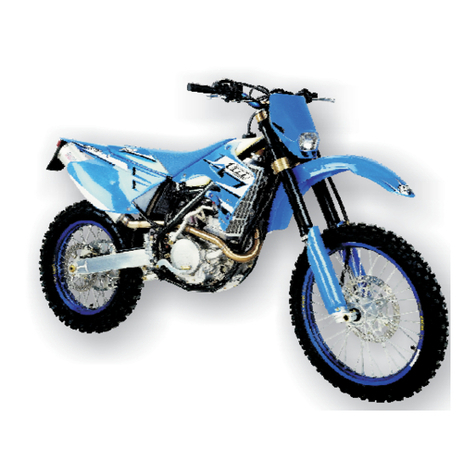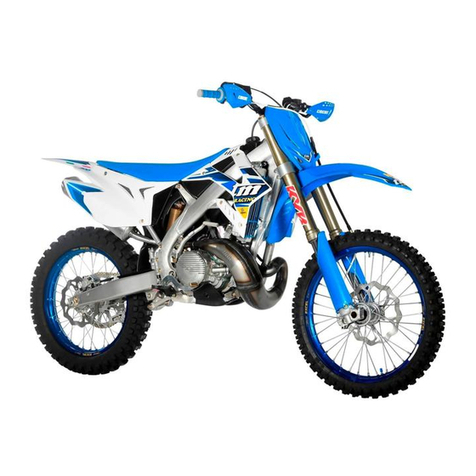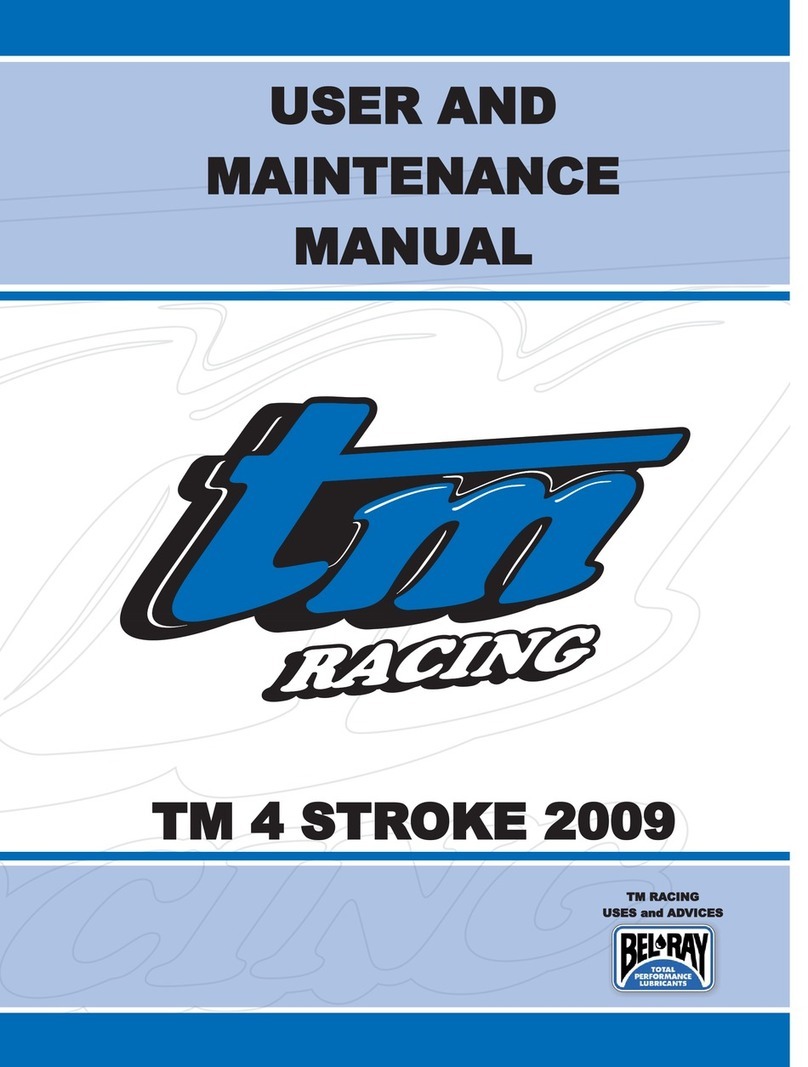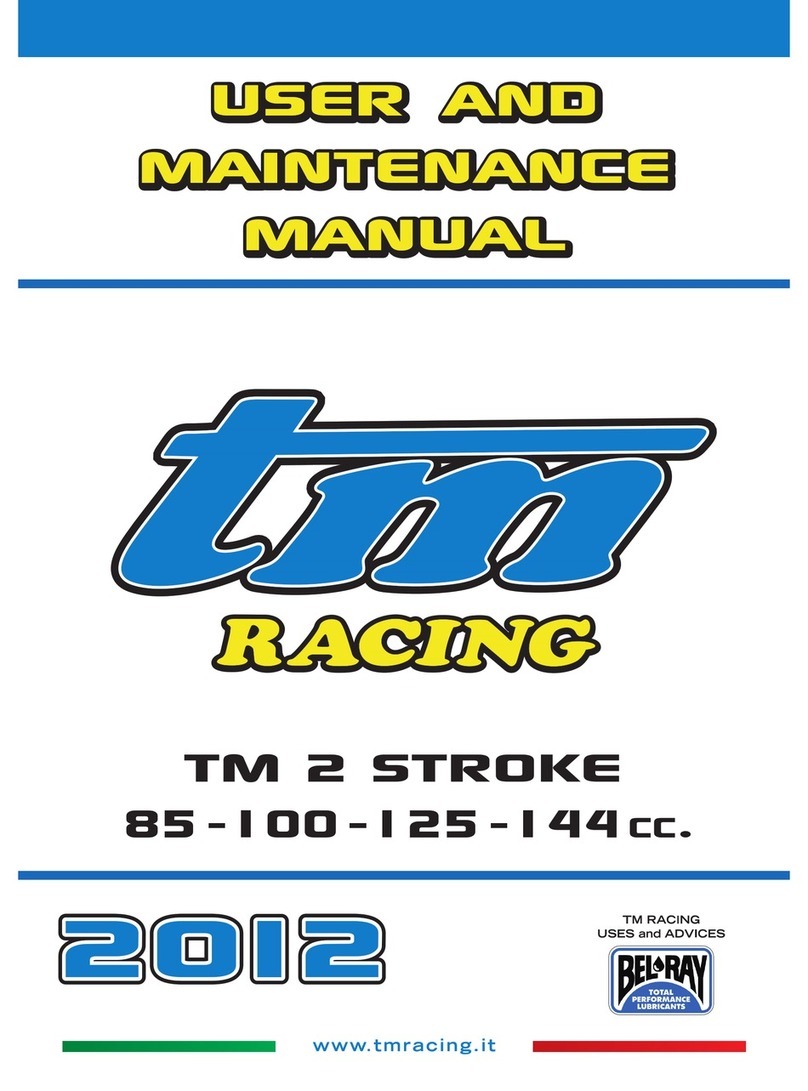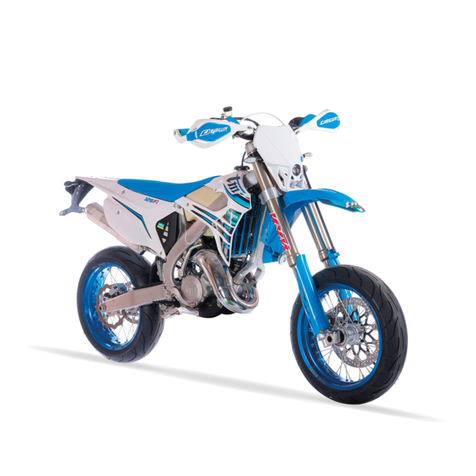ENGLISH
ENGLISH
6
INDEXINDEX
INDEXINDEX
INDEX
INDEXINDEX
INDEXINDEX
INDEX
Page
INDEX ............................................................................................. 6
POSITION OF SERIAL NUMBER .................................................. 7
Frame number ................................................................................ 8
Engine number ............................................................................... 8
OPERATING CONTROLS............................................................... 9
Clutch lever .................................................................................... 10
Manual decompressor lever .......................................................... 10
Front brake lever............................................................................ 10
Control pilot lights ........................................................................ 10
Electronic tachometer (END/SMR/SMM)........................................... 11
Mode selection and reset .............................................................. 11
Programming the electronic tachometer ......................................... 11
Programming the clock ................................................................... 12
Setting the distance travelled ......................................................... 12
Engine stop switch (MX/SMX) ....................................................... 12
Combination switch (END/SMR/SMM) ............................................. 12
Start command and emergency stop
(END/MXe.s./SMXe.s./SMR/SMM)................................................... 13
Fuel filler cap...................................................................................13
Fuel tap.......................................................................................... 13
Choke command (cold starter) ....................................................... 14
“By-Pass” command(hot starter) ................................................ 14
Idle speed adjustment command .................................................... 14
Gear shift pedal...............................................................................15
Kickstart pedal................................................................................ 15
Brake pedal ................................................................................... 15
Side stand ...................................................................................... 15
Side stand fixing for off-road routes...............................................16
Ignition switch ............................................................................... 16
Fork adjustment in compression .................................................... 16
Fork adjustment in rebound .......................................................... 17
Shock absorber adjustment in compression....................................17
Shock absorber adjustment in rebound ......................................... 18
Steering lock .................................................................................. 19
ADVICEAND GENERAL RECOMMENDATIONS FOR
COMMISSIONING THE MOTORCYCLE......................................... 21
Indications for first start-up .......................................................... 22
Running in instructions .............................................................. 22
INSTRUCTIONS FOR USE ..............................................................23
Check before every start-up ........................................................ 24
Cold engine start .............................................................. 25
Warm engine start.......................................................................... 25
If the engine is “flooded! ................................................................ 26
Bike starting.....................................................................................26
Shifting gear, accelerating, slowing down .................................. 26
Braking........................................................................................... 28
Stopping and parking ..................................................................... 28
Fuel ................................................................................................ 29
MAINTENANCE AND LUBRICATION TABLE................................. 31
FRAME AND ENGINE MAINTENANCE ........................................... 37
Check steering bearings and play adjustment .............................. 38
Telescopic fork vent screws ......................................................... 39
Cleaning telescopic fork dust scraper.............................................39
Basic calibration of the chassis on the basis of pilot weight ........... 40
Shock absorber calibration and spring check................................ 40
Establishing rear shock lowering in running order ........................ 40
Establishing rear shock static lowering ........................................ 41
Check telescopic fork basic calibration ......................................... 41
Variation of telescopic fork preload .............................................. 41
Replacement of fork springs.......................................................... 42
Variation of rear shock spring preload........................................... 42
Page
Rear suspension mechanical linkage............................................. 42
Check chain tension ...................................................................... 43
Adjustment of chain tension (all models except SMM).....................43
Adjustment of chain tension (SMM).................................................44
Chain maintenance......................................................................... 44
Chain wear..................................................................................... 45
Basic indications for TM disc brakes ............................................. 45
Free play adjustment of front brake lever....................................... 46
Check front brake fluid level ......................................................... 47
Top-up front brake fluid ................................................................. 47
Check front brake pads ................................................................ 47
Replacement of front brake pads................................................... 48
Modification of rear brake pedal base position .............................. 49
Check rear brake fluid level .......................................................... 49
Top-up rear brake fluid................................................................... 49
Check rear brake pads ................................................................. 50
Replacement of rear brake pads.................................................... 50
Disassembly and assembly of front wheel ................................... 50
Disassembly and assembly of rear wheel (all except SMM) ......... 51
Disassembly and assembly of rear wheel (SMM).......................... 52
Check spoke tension ..................................................................... 52
Tyres, tyre pressure ...................................................................... 53
Battery (all models with E.S.)......................................................... 53
Check/adjustment magnet sensor distance .................................. 53
Battery charge ............................................................................. 54
Recharge fuse (all models with E.S.) ............................................ 55
Services fuse (all models with lights) ............................................55
Replacement of headlight/position light bulb .................................. 55
Replacement of headlight/position light bulb (with cyclops)........... 56
Replacement of rear position/stop/numberplate light bulb
(END/ SMR/SMM)........................................................................... 56
Replacement of direction indicator bulb ......................................... 56
Cooling ........................................................................................... 57
Check coolant level ...................................................................... 58
Emptying, filling and bleeding of the cooling system........................58
Replacement of exhaust silencer packing material..........................58
Cleaning the air filter ...................................................................... 59
Check hand decompressor adjustment ......................................... 59
Throttle cable command adjustment .............................................. 60
Adjustment of clutch lever basic position....................................... 60
Check hydraulic clutch oil level ..................................................... 60
Bleeding hydraulic clutch ............................................................. 60
Carburetor - Idle speed adjustment................................................ 61
Basic indications regarding carburetor wear................................. 61
Check fuel level (float height) ....................................................... 62
Emptying the carburetor float bowl..................................................62
Oil circuit........................................................................................ 62
Check engine oil level ................................................................... 63
Engineoil ....................................................................................... 63
Change engine oil ...........................................................................63
TROUBLESHOOTING ................................................................. 66
CLEANING ................................................................................. 68
PRECAUTIONSFOR WINTER USE .............................................. 68
STORAGE ................................................................................. 68
Start-up after seasonal pause........................................................... 68
TECHNICAL DATA - ENGINE.................................................... 69/70
CARBURETORSETTINGS ............................................................ 71
ENGINETIGHTENINGTORQUES .................................................. 72
TECHNICAL DATA-CYCLE PART ........................................... 73-74
ALPHABETIC INDEX ................................................................... 75
WIRING DIAGRAM .......................................................... appendix
